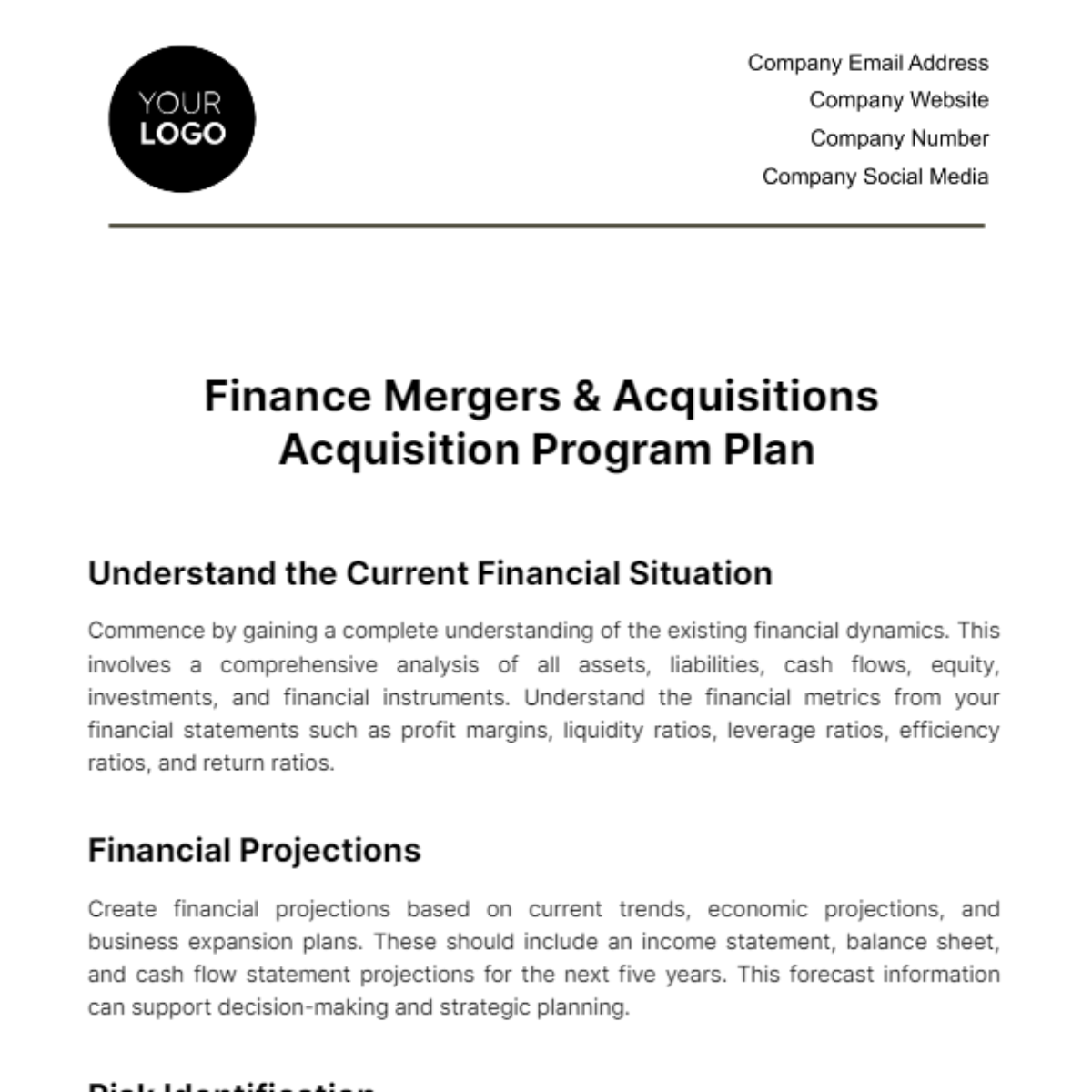Free Finance Mergers & Acquisitions Acquisition Program Plan

Understand the Current Financial Situation
Commence by gaining a complete understanding of the existing financial dynamics. This involves a comprehensive analysis of all assets, liabilities, cash flows, equity, investments, and financial instruments. Understand the financial metrics from your financial statements such as profit margins, liquidity ratios, leverage ratios, efficiency ratios, and return ratios.
Financial Projections
Create financial projections based on current trends, economic projections, and business expansion plans. These should include an income statement, balance sheet, and cash flow statement projections for the next five years. This forecast information can support decision-making and strategic planning.
Risk Identification
A part of this plan necessitates the detection and detailing of possible risks to the financial health of the company. These risks could sprout from several sources, including economic instability, loss of major clients, cost inflation, or increased competition. It's imperative to dissect as many potential risk factors as possible at this stage.
Risk Assessment and Mitigation
A. Financial Risks:
Rigorous scenario analysis will identify potential financial risks, including exposure to currency fluctuations and interest rate volatility. Mitigation strategies will be crafted to hedge against these risks and safeguard the financial health of the combined entity.
B. Operational Risks:
Thorough operational due diligence will uncover potential integration challenges and workforce alignment issues. Mitigation plans will focus on seamless integration, employee engagement, and proactive measures to address any disruptions in the supply chain.
C. Legal and Regulatory Risks:
Legal experts will conduct a comprehensive review to identify potential legal and regulatory risks. Our strategy involves close collaboration with legal advisors to ensure compliance at every stage of the acquisition, minimizing legal uncertainties.
Maximizing Shareholder Value
Perform an intrinsic value analysis to determine ways to maximize shareholder value. Adjust strategies based on the calculated value to ensure investor return. Additionally, maintaining a strong focus on sustainable growth, profitability, cash flow, and risk management can contribute to value enhancement.
Achieving Strategic Goals
Align the financial plan with broader strategic goals. Financial strategies must serve to facilitate the achievement of these objectives. They should offer financial flexibility to allow the pursuit of strategic initiatives and adapt to changing business environments.
Plan Monitoring and Control
It's essential to regularly track and monitor the progress of the financial plan. Use a set of pre-defined KPIs for this purpose. Furthermore, having a strong financial control system in place can help identify deviations from the plan and suggest corrective actions as soon as possible.
Feedback and Continuous Improvement
Encourage feedback from various stakeholders to identify areas of improvement. Make necessary modifications to optimize financial performance. This ongoing feedback cycle can help ensure that financial goals remain aligned with business and strategic objectives.
Communication Strategy
A. Internal Communication
Change Management:
A robust change management plan will accompany the communication strategy, guiding employees through the transition. Regular town hall meetings, Q&A sessions, and internal forums will address concerns and maintain transparency.
Employee Training:
Tailored training programs will be implemented to equip employees with the necessary skills and knowledge for the post-acquisition environment. Continuous support and communication channels will be established to facilitate a smooth adaptation process.
B. External Communication
Stakeholder Messaging:
Crafting consistent and transparent messages for external stakeholders, including investors, customers, and partners, will be a priority. Timely and accurate information will be disseminated through press releases, public statements, and targeted communications.
Market Perception Management:
Proactively managing market perception through proactive communication will mitigate uncertainties. A dedicated public relations strategy will highlight the strategic rationale and positive outcomes of the acquisition, reinforcing confidence in the market.
- 100% Customizable, free editor
- Access 1 Million+ Templates, photo’s & graphics
- Download or share as a template
- Click and replace photos, graphics, text, backgrounds
- Resize, crop, AI write & more
- Access advanced editor
Explore the Finance Mergers & Acquisitions Acquisition Program Plan Template on Template.net. This editable and customizable template, powered by an intuitive AI Editor Tool, streamlines your strategic journey. Maximize shareholder value, mitigate risks, and achieve strategic goals seamlessly. Elevate your M&A game with this comprehensive guide, making your acquisition process efficient and effective.





























